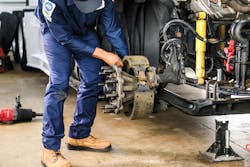Trucking's Fountain of Youth: Repairs and replacements
This is Part Two of a two-part story.
With supply chain shortages necessitating older vehicles staying on the road longer than before, shops need to begin considering how to make their aged vehicles last. In Part One of this two-part story, we discussed how shops can adapt their preventive maintenance for longer-lasting assets and when to start shifting their practices. Part Two examines aftertreatment systems and engine rebuilds.
Aftertreatment not an afterthought
Turning our attention to the aftertreatment system, a fleet must remember that upstream issues have a downstream effect. If the DPF ever fails, the technician must determine the true cause.
“With older trucks, look closely at the service histories,” said Dave Jerman, sales director for Roadwarrior Inc., a provider of aftermarket DPFs and other aftertreatment parts. “Has the turbo ever been replaced? Was there ever oil contamination? Have there been any EGR or coolant leaks? Have you had a bad seventh injector, which can cause hydrocarbon poisoning? Knowing the cause and effect is important in order to get a proper diagnosis and avoid throwing good money at a bad investment.”
For instance, one of Jerman’s fleet customers had replaced a failed DPF. They also cleaned the diesel oxidation catalyst (DOC), which is considered best practice. But with older vehicles, the DOC’s coating may have deteriorated over time. The fleet performed a forced regen to test the temperature rise. Everything checked out OK. But according to Jerman, that gave a false sense of security because the test only shows if the DOC is dead on arrival.
Read more: How fuel-operated heaters ease aftertreatment issues
“This truck continued seeing active regens far too often,” Jerman said. “We found out the truck had a failed turbo in the past. That’s a big red flag because a failed turbo creates a strong possibility of DOC contamination. The 20x increase in active regens the fleet was still experiencing was an indicator that the DOC needed to be replaced. Sure enough, the fleet replaced the DOC and the active regen cycle normalized, to a large degree.”
One of the best and easiest things a fleet can do with older vehicles is to begin paying attention to regen cycles.
“When active regens start to take over, you might have a problem,” Jerman said. “Look at the service history and establish a baseline for what is normal. The good thing is that the ECU will provide data on active regen events so you can establish an accurate baseline.”
Fuel additives can be another useful tool from a preventative standpoint. Products like Hot Shot’s Secret Everyday Diesel Treatment and Diesel Extreme include a cetane booster that helps burn fuel more completely.
“You end up with a lot less soot going through the system,” said Josh Steinmetz, brand manager at Lubrication Specialties. “We have data that shows regens can be reduced by 50%, all while helping extend the life of the aftertreatment system.”
Stay ahead of the problem
After five years or 500,000 miles, fleets can also start thinking about the proactive replacement of certain components—before their eventual failure leads to more serious problems. Dan Nynas, COO of Diesel Laptops, already touched on O-rings and air dryers in Part One. But there are other elements consider.
For instance, director of service operations, J. Ellis, at the dealership Kenworth Northeast, said technicians should inspect for bushings that appear dry-rotted or cracked. “You always want to replace worn bushings before the damage gets through the bushing,” Ellis said. “If that happens, then you’re having to replace hard parts, which sometimes you can’t even get these days.”
Leaf springs, airbags, and rear suspension could also be replaced proactively. “You know these things aren’t going to last forever anyway,” Ellis said. “By replacing these types of components that help absorb shocks on the road, you’ll allow your chassis and cab to last longer.”
Fleets can also start thinking about predictive maintenance. Consider the year, make, and model of the vehicle. Determine which components have a history of failure at a certain point, perhaps a NOx or particulate sensor. It might be a good idea to begin replacing some of those items before they result in a breakdown.
Jeff Celantano, technical data manager at Diesel Laptops, is a big fan of predictive maintenance software that can identify patterns by looking across a vast population of similar vehicles. Short of that, a fleet can simply look at its own assets, taking note of when certain components needed to be replaced on other like vehicles.
Whatever the approach, predictive maintenance can also help fleets alleviate any potential parts availability issues when a component is unexpectedly needed. By planning ahead, a fleet could assemble its own inventory of needed items.
Rebuild your peace of mind
For fleets pushing their linehaul trucks beyond the five-year mark, another good preventative measure to consider is an engine rebuild.
“It is definitely a good idea to do an in-frame rebuild by around 750,000 miles, or maybe even do an out-of-frame and replace all the gaskets,” Ellis said. “If you just wait to see if you’ll have a failure, and then you have a failure, it’s going to be far more expensive. You may end up causing damage to the block, crank, or camshaft.”
Keep in mind that a rebuild may be necessary much sooner than 750,000 miles. Andrew Plant, manager of powertrain service engineering at Daimler Truck North America, said the need for an overhaul is dependent on the vehicle’s application, as well as the level of preventive maintenance that has been adhered to throughout the vehicle’s life. For a fleet that is past the 500,000-mile mark, it’s time to start looking for clues that an overhaul could be needed.
“Indications can include oil consumption increases, fuel economy decreases, low power, and difficulty starting in colder weather,” Plant said. “The decision for an overhaul shouldn’t be based on a single factor.”
The motivation for an overhaul, however, is based on one factor: getting reliable performance out of that truck. To that end, Plant said a fleet should thoroughly evaluate the vehicle’s overall condition before investing in a rebuild. He’s talking about things like the transmission, clutch, axles, suspension, and any specialized equipment.
If the decision is made to rebuild the engine, Plant offered one more piece of advice. “When an engine is rebuilt by a trained and qualified technician with OEM parts, the owner can expect an exceptional second life.”
A fleet may also want to start thinking about proactive transmission and clutch service. Ellis said rebuilds are generally out of the question due to cost. But replacement could be a good investment if the fleet must continue relying on that truck.
“I would strongly consider going to an OEM replacement,” Ellis said. “If you made it 750,000 miles with the same clutch, I wouldn’t skimp on the replacement. Plus, replacing with new gives you another three- or four-year warranty.”
Speaking of warranties, extended warranties can be another useful tool for fleets looking to get more life out of their linehaul trucks.
Of course, basic wear items like bushings aren’t covered, which is why a big part of an older truck’s “fountain of youth” strategy must always include thorough inspections and proactive, predictive, and preventative maintenance.
About the Author

Gregg Wartgow
Gregg Wartgow is a freelancer who Fleet Maintenance has relied upon for many years, writing about virtually any trucking topic. He lives in Brodhead, Wisconsin.


